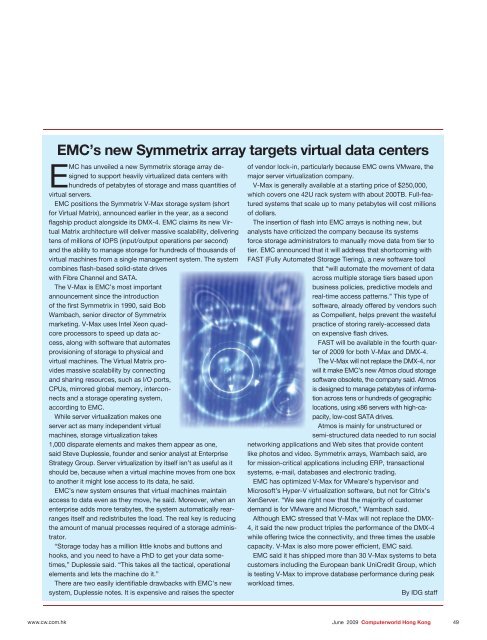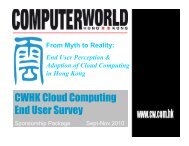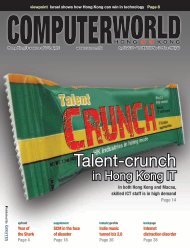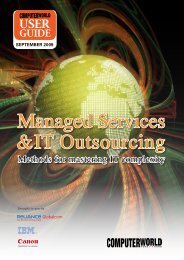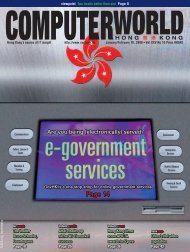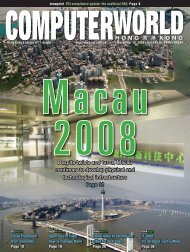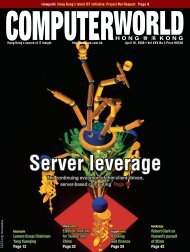Download - enterpriseinnovation.net
Download - enterpriseinnovation.net
Download - enterpriseinnovation.net
- No tags were found...
You also want an ePaper? Increase the reach of your titles
YUMPU automatically turns print PDFs into web optimized ePapers that Google loves.
EMC’s new Symmetrix array targets virtual data centersEMC has unveiled a new Symmetrix storage array designedto support heavily virtualized data centers withhundreds of petabytes of storage and mass quantities ofvirtual servers.EMC positions the Symmetrix V-Max storage system (shortfor Virtual Matrix), announced earlier in the year, as a secondtualMatrix architecture will deliver massive scalability, deliveringtens of millions of IOPS (input/output operations per second)and the ability to manage storage for hundreds of thousands ofvirtual machines from a single management system. The systemwith Fibre Channel and SATA.The V-Max is EMC’s most importantannouncement since the introductionWambach, senior director of Symmetrixmarketing. V-Max uses Intel Xeon quadcoreprocessors to speed up data access,along with software that automatesprovisioning of storage to physical andvirtual machines. The Virtual Matrix providesmassive scalability by connectingand sharing resources, such as I/O ports,CPUs, mirrored global memory, interconnectsand a storage operating system,according to EMC.While server virtualization makes oneserver act as many independent virtualmachines, storage virtualization takes1,000 disparate elements and makes them appear as one,said Steve Duplessie, founder and senior analyst at EnterpriseStrategy Group. Server virtualization by itself isn’t as useful as itshould be, because when a virtual machine moves from one boxto another it might lose access to its data, he said.EMC’s new system ensures that virtual machines maintainaccess to data even as they move, he said. Moreover, when anenterprise adds more terabytes, the system automatically rearrangesitself and redistributes the load. The real key is reducingthe amount of manual processes required of a storage administrator.“Storage today has a million little knobs and buttons andhooks, and you need to have a PhD to get your data sometimes,”Duplessie said. “This takes all the tactical, operationalelements and lets the machine do it.”system, Duplessie notes. It is expensive and raises the specterof vendor lock-in, particularly because EMC owns VMware, themajor server virtualization company.V-Max is generally available at a starting price of $250,000,which covers one 42U rack system with about 200TB. Full-featuredsystems that scale up to many petabytes will cost millionsof dollars.analysts have criticized the company because its systemsforce storage administrators to manually move data from tier totier. EMC announced that it will address that shortcoming withFAST (Fully Automated Storage Tiering), a new software toolthat “will automate the movement of dataacross multiple storage tiers based uponbusiness policies, predictive models andreal-time access patterns.” This type ofsoftware, already offered by vendors suchas Compellent, helps prevent the wastefulpractice of storing rarely-accessed dataFAST will be available in the fourth quarterof 2009 for both V-Max and DMX-4.The V-Max will not replace the DMX-4, norwill it make EMC’s new Atmos cloud storagesoftware obsolete, the company said. Atmosis designed to manage petabytes of informationacross tens or hundreds of geographiclocations, using x86 servers with high-capacity,low-cost SATA drives.Atmos is mainly for unstructured orsemi-structured data needed to run social<strong>net</strong>working applications and Web sites that provide contentlike photos and video. Symmetrix arrays, Wambach said, arefor mission-critical applications including ERP, transactionalsystems, e-mail, databases and electronic trading.EMC has optimized V-Max for VMware’s hypervisor andMicrosoft’s Hyper-V virtualization software, but not for Citrix’sXenServer. “We see right now that the majority of customerdemand is for VMware and Microsoft,” Wambach said.Although EMC stressed that V-Max will not replace the DMX-4, it said the new product triples the performance of the DMX-4while offering twice the connectivity, and three times the usableEMC said it has shipped more than 30 V-Max systems to betacustomers including the European bank UniCredit Group, whichis testing V-Max to improve database performance during peakworkload times.By IDG staffwww.cw.com.hkJune 2009 Computerworld Hong Kong 49


